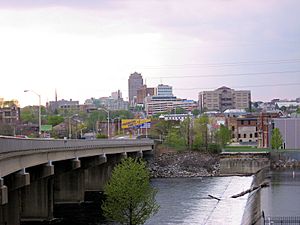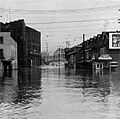Climate of Allentown, Pennsylvania facts for kids
The climate of Allentown, Pennsylvania is known as a humid continental climate. This means it has four distinct seasons. Summers are usually hot and humid, while winters are cold. Allentown gets about 45.35 inches (1,152 mm) of rain and snow each year.
The warmest month in Allentown is typically July. The average temperature then is around 74.7 °F (23.7 °C). January is usually the coldest month. Its average temperature is about 29.4 °F (−1.4 °C).
Sometimes, Allentown experiences strong weather. This often includes thunderstorms and heavy rain that can cause flooding. In winter, snow is common. Some years have light snowfall, while others get big snowstorms. These can be from storms called Nor'easters. Ice, sleet, and freezing rain can also happen in winter. These conditions can make roads dangerous.
Tropical storms and hurricanes sometimes travel up the Atlantic Ocean coast. They can reach Pennsylvania. For example, Hurricane Ivan in 2004 and Hurricane Sandy in 2012 caused damage in Allentown.
Contents
Allentown's Weather Records
Allentown has been keeping detailed weather records since 1922. These records show some of the most extreme weather events the city has experienced.
Temperature Records
- The hottest temperature ever recorded was 105 °F (41 °C). This happened on July 3, 1966.
- The lowest daily high temperature was 2 °F (−17 °C). This was on January 19, 1994.
- The highest daily low temperature was 79 °F (26 °C). This occurred on July 15, 1995.
- The coldest temperature ever recorded was −15 °F (−26 °C). This happened on January 21, 1994.
- The highest average temperature for one day was 91.0 °F (32.8 °C). This was on July 22, 2011.
- The lowest average temperature for one day was −4.5 °F (−20.3 °C). This was on January 19, 1994.
Rain and Snow Records
- The most rain in 24 hours was 8.71 in (221.2 mm). This happened on October 8, 2005.
- The most snow in 24 hours was 24.0 in (61.0 cm). This fell on February 11, 1983.
- The deepest snow on the ground was 28 in (71 cm). This was on February 12, 1983.
Seasons in Allentown
Allentown experiences four distinct seasons, each with its own unique weather patterns.
Summer Weather
Summers in Allentown are usually hot and very humid. Temperatures often reach the mid-80s and low-90s. The average high temperature is about 84 °F (29 °C). However, it can get much hotter, with the record being 105 °F (41 °C). The air often feels sticky because of high humidity. Rain is common, often with strong thunderstorms. These storms bring a lot of rain but usually don't last long. Most homes use Air conditioning to stay cool and comfortable.
Autumn Weather
Autumn, or fall, is generally mild in Allentown. Daytime temperatures are often in the 60s and 70s. This season brings more wind and sometimes heavier rain. Trees begin to lose their leaves, preparing for winter. Sometimes, a period of warm, sunny weather called Indian summer can happen.
Winter Weather
Winters in Allentown are cool to cold. January's average high temperature is around 35 °F (2 °C). Snowfall is common, but the amount can change a lot each year. Snow, ice, sleet, and freezing rain can cause problems on roads. They can also lead to school closures. For example, in February 2007, a highway near the city was closed. Drivers were stuck for many hours due to overturned trucks. Winter sports like snowboarding and skiing are popular. People can enjoy them in the Pocono Mountains nearby.
Spring Weather
Spring is a time of new growth in Allentown. New grass starts to grow, and flowers begin to bloom. Animals come out of hibernation. The city and its surroundings become filled with sunshine. Temperatures start to rise. March and April often bring a lot of rain. This rain can be light but last for many hours. This leads to warmer May and June months. Many residents start planning trips to the shore as the weather gets nicer.
Natural Disasters
Allentown can experience several types of natural disasters.
Hurricanes, tropical storms, and tropical depressions are possible threats in the summer. Severe thunderstorms are an even bigger risk. They can cause flash flooding, where water rises very quickly. When flash flooding happens, mudslides are rare but can occur. Tornadoes and earthquakes are also rare but have been reported in the past. Major snowstorms, called Blizzards, happen about every ten to fifteen years.
Images for kids
-
An Allentown snow storm in 1918
-
Hamilton and Front Streets in Center City Allentown during the 1942 Allentown flood
-
The Great Flood of Allentown in 1933
-
A winter snow storm in Allentown in 2016
| Climate data for Allentown, Pennsylvania (Lehigh Valley Int'l), 1981–2010 normals, extremes 1922–present | |||||||||||||
|---|---|---|---|---|---|---|---|---|---|---|---|---|---|
| Month | Jan | Feb | Mar | Apr | May | Jun | Jul | Aug | Sep | Oct | Nov | Dec | Year |
| Record high °F (°C) | 72 (22) |
77 (25) |
87 (31) |
93 (34) |
97 (36) |
100 (38) |
105 (41) |
100 (38) |
99 (37) |
92 (33) |
81 (27) |
72 (22) |
105 (41) |
| Mean maximum °F (°C) | 57.9 (14.4) |
59.6 (15.3) |
71.6 (22.0) |
82.5 (28.1) |
88.2 (31.2) |
91.9 (33.3) |
94.2 (34.6) |
92.5 (33.6) |
88.0 (31.1) |
79.0 (26.1) |
70.6 (21.4) |
59.7 (15.4) |
95.4 (35.2) |
| Mean daily maximum °F (°C) | 36.0 (2.2) |
39.8 (4.3) |
49.4 (9.7) |
61.3 (16.3) |
71.5 (21.9) |
80.1 (26.7) |
84.2 (29.0) |
82.4 (28.0) |
74.9 (23.8) |
63.6 (17.6) |
52.5 (11.4) |
40.5 (4.7) |
61.4 (16.3) |
| Mean daily minimum °F (°C) | 19.5 (−6.9) |
21.7 (−5.7) |
28.8 (−1.8) |
38.5 (3.6) |
48.3 (9.1) |
58.1 (14.5) |
62.7 (17.1) |
60.9 (16.1) |
52.9 (11.6) |
41.3 (5.2) |
32.9 (0.5) |
24.0 (−4.4) |
40.8 (4.9) |
| Mean minimum °F (°C) | 3.0 (−16.1) |
5.7 (−14.6) |
13.1 (−10.5) |
26.0 (−3.3) |
35.5 (1.9) |
46.3 (7.9) |
52.6 (11.4) |
49.8 (9.9) |
39.2 (4.0) |
28.8 (−1.8) |
19.9 (−6.7) |
9.1 (−12.7) |
0.2 (−17.7) |
| Record low °F (°C) | −15 (−26) |
−12 (−24) |
−5 (−21) |
12 (−11) |
28 (−2) |
39 (4) |
46 (8) |
41 (5) |
30 (−1) |
21 (−6) |
3 (−16) |
−8 (−22) |
−15 (−26) |
| Average precipitation inches (mm) | 3.03 (77) |
2.70 (69) |
3.39 (86) |
3.56 (90) |
4.14 (105) |
4.31 (109) |
4.95 (126) |
3.69 (94) |
4.62 (117) |
3.88 (99) |
3.50 (89) |
3.58 (91) |
45.35 (1,152) |
| Average snowfall inches (cm) | 10.0 (25) |
11.1 (28) |
4.9 (12) |
1.0 (2.5) |
0 (0) |
0 (0) |
0 (0) |
0 (0) |
0 (0) |
0 (0) |
0.7 (1.8) |
5.2 (13) |
32.9 (84) |
| Average precipitation days (≥ 0.01 in) | 11.1 | 9.8 | 11.0 | 12.1 | 12.1 | 11.4 | 10.9 | 9.5 | 9.1 | 9.1 | 9.8 | 10.9 | 126.8 |
| Average snowy days (≥ 0.1 in) | 5.6 | 4.8 | 2.5 | 0.4 | 0 | 0 | 0 | 0 | 0 | 0 | 0.6 | 3.5 | 17.4 |
| Average relative humidity (%) | 69.1 | 66.7 | 62.6 | 60.9 | 65.6 | 67.9 | 68.8 | 71.9 | 74.0 | 71.8 | 70.5 | 71.4 | 68.4 |
| Source: NOAA (relative humidity 1961–1990) | |||||||||||||






